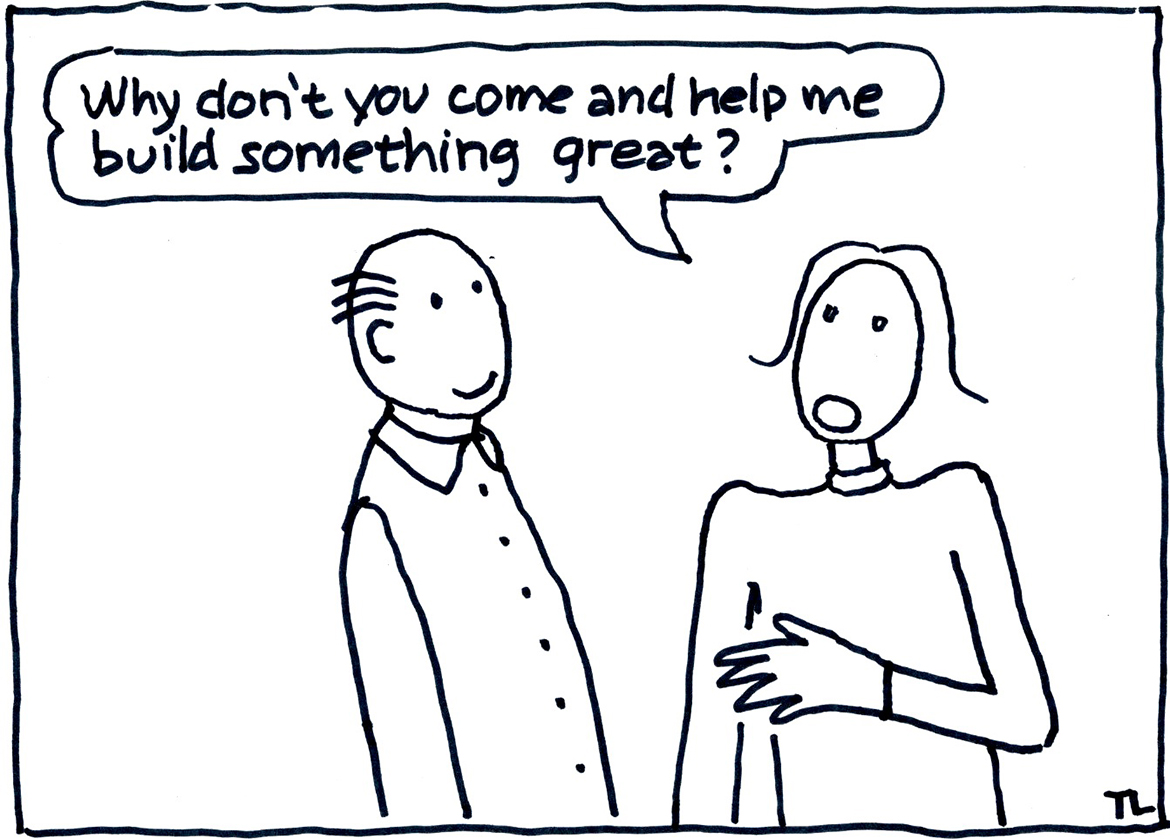Ten Things I Learned About Leadership Early in My Career

My first job out of art school was as a design illustrator with the Boeing Company design group. I was thrilled to be getting paid to design, but I knew right away I wanted more opportunity to grow.
I knew that I needed:
- a connection to the larger professional community.
- a design consultancy with some renown.
- a place that challenged me to develop my skills.
At Boeing my skills got a real workout. I was drawing, painting, and designing every day. It was my first experience working with other designers, all of whom were far more skilled than I.
Over the weekends I polished my portfolio and at lunchtime I made appointments to show my book.
Soon I discovered Kevin & Dotson, a small firm doing world-class design work for corporate clients and universities. I studied their work, copied their style, and created new portfolio samples that I thought would appeal to them. Finally feeling ready, I made an appointment to show my book.
The firm was in a hundred-year-old building in an emerging neighborhood of advertising agencies, writers, designers, and illustrators. The office was a walk-up built on top of the sixth floor of the building; a penthouse. I was nervous, but prepared. I’d read the Communications Arts magazine article about the firm. I’d seen their photos. I even dressed like them: wingtip shoes, dark suit, white shirt, and a skinny solid tie. My book was full of brochures that looked like they could have designed and illustrations that mimicked the illustrators they hired.
It paid off. First they hired me as a freelance illustrator. The assignments forced me to stretch, and provided a touch of what it was like to work with large corporations and sophisticated communication executives.
Looking back, I realize that my approach was classic for gaining entry. I knew what I needed to get my career going: a mentor who was doing the kind of work that I wanted to do; a design leader with the accounts to prove it. In my mind it was all about the work and the vibe of the place. It had to fit my emerging sense of cool. I found it in Kevin, the creative partner.
Of course I wanted to be paid, and had a moment of anxiety, thinking, “What if they offer me less money than my last position? What will I do?” I was in a terrible negotiating position and needed this job to get to the next rung on the ladder. But these were good guys who gave me a nice step-up in pay. I would have taken the job for less, as my goal was advancement.
The first five years were fantastic. The work included sales literature, corporate identity, annual reports, and packaging. The firm won a string of awards, made money, and grew.
Around the five-year mark I began getting restless. Dotson had left the partnership and Kevin didn’t work collaboratively. He either gave me direction on his jobs, or he’d give the project completely to me. I got to do my own thing, but there was no back and forth, no discussion, no sharing of ideas, no critique. Dotson had been a collaborator. Kevin would say I was fantastic, but he never said why.
By now I was married with a four-year-old and a sizable mortgage. I needed more money. I didn’t have enough confidence to get Kevin into a conversation about where the business was going. I was supremely overconfident in my work, but in any other area I was helpless.
However, I did learn some valuable lessons:
Lesson 1: If you know why people have selected you to work for them, it will help you understand their motivations.
Lesson 2: When you hire people who put in extra effort to work for you, they will pay you back handsomely.
Lesson 3: Leaders must live up to the expectations of their followers, just as followers must perform up to the leader’s requirements.
Lesson 4: With any group, personalities, skills, and their acceptance of the new person are as important as the work.
Lesson 5: A leader can’t win back a creative person once their heart is set on leaving.
Lesson 6: The work environment must match or exceed the expectations of the leader’s followers.
Lesson 7: Everyone needs praise that tells them exactly what they are doing right and specific criticism of what they are doing incorrectly. We all need both in small doses as close to the incident under question as possible.
Lesson 8: Good managers are approachable and invite discussion from team members, including critique.
Lesson 9: Leaders are responsible for insuring that there is enough new business to keep the enterprise growing. They are responsible for providing a future for their followers and the firm.
Lesson 10: Leaders must continuously articulate where the organization is going, why the direction is a good one, and how the organization will get to that future.
Kevin was the leader I needed to get my career started. I learned a great deal, but his leadership was through his technical skills. He didn’t articulate a future I could buy in to, and so I moved on.
This article first appeared at TalentZoo.

